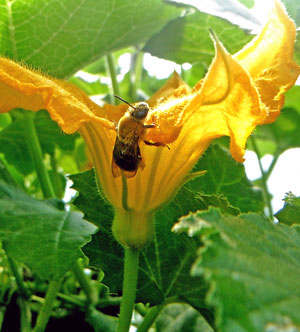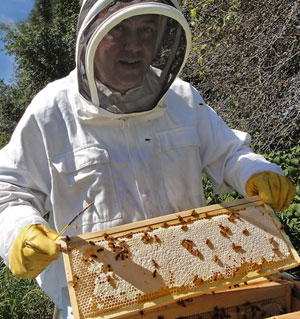What is in honey?
 Nectar is the main ingredient collected by honey bees to make honey. Although only nectar is used to make honey quite a bit of pollen finds its way into the honey. The bee will store the pollen separately from the honey and it will provide them with the protein, minerals and vitamins they need in their diet. Bees carry pollen back to the hive in pollen sacks on their legs. The flower's nectar is carried back to the hive in the bee's stomach.
Nectar is the main ingredient collected by honey bees to make honey. Although only nectar is used to make honey quite a bit of pollen finds its way into the honey. The bee will store the pollen separately from the honey and it will provide them with the protein, minerals and vitamins they need in their diet. Bees carry pollen back to the hive in pollen sacks on their legs. The flower's nectar is carried back to the hive in the bee's stomach.
Carbohydrates
(80-90%) fructose and glucose.
Organic Acids
Gluconic, citric, melic, formic, and others.
Proteins and Amino Acids
Amino acids from pollen.
Minerals
Calcium, sodium, phosphorus, magnesium, silicon, iron, manganese, copper, and others.
Enzymes
Invertase, glucose oxidase, amylase.
Vitamins
A1, B1, B6, B12, C, D, E, folic acid.
Antioxidants
Pinocembrin, pinobanksin, chrysin and galagin. Pinocembrin is only found in honey. Ascorbic acid (vitamin C), catalase and selenium are also found.  Bees add the enzyme invertase to flower nectar which converts sucrose into glucose and fructose. Honey bees also add the enzyme glucose oxidase to the flower nectar which oxidizes glucose to produce gluconic acid and small amounts of hydrogen peroxide. This in turn reduces the pH of the honey making it more acidic, averaging 4 pH for North American honeys.
Bees add the enzyme invertase to flower nectar which converts sucrose into glucose and fructose. Honey bees also add the enzyme glucose oxidase to the flower nectar which oxidizes glucose to produce gluconic acid and small amounts of hydrogen peroxide. This in turn reduces the pH of the honey making it more acidic, averaging 4 pH for North American honeys.
The combination of low pH, low water content (under 18%) and the presence of hydrogen peroxide (H2O2) creates an environment that is unfriendly to bacteria and microbes. Because of this natural honey can last indefinitely in a sealed container.
What is in Pollen?
Vitamins
Provitamin A (beta-carotene) (carotenoids), Vitamin B1 (thiamine), Vitamin B2 (riboflavin), Vitamin B3 (niacin), Vitamin B5 (pantothenic acid), Vitamin B6 (pyridoxine), Vitamin B12 (cyamocobalamin), Biotin, Vitamin C (ascorbic acid), Vitamin D & Vitamin E, Vitamin K, Choline & Inositol, Folic Acid, Rutin, Vitamin PP (nicotinicamide).
Minerals
Calcium & Iron, Phosphorus & Copper, Potassium, Magnesium & Sodium (electrolytes), Manganese & Selenium, Silica (great for the hair, skin & nails), Sulphur & Titanium, Zinc (needed for the immune system), Iodine & Chlorine, Boron & Molydbenum.
Enzymes & Coenzymes
Diastase & Phosphatase, Amylase & Catalase, Saccharase & Diaphorase, Pectase & Cozymase, Lactic dehydrogenase, Succinic dehydrogenase.
Most of honey's medicinal benefits are attributed to its antibacterial and anti fungal properties. These properties have been shown in the laboratory by introducing honey to a specific bacteria/fungus in a petri dish and measuring the degree of inhibition of its growth. Honey's usefulness as a medicine for humans is partly anecdotal and more recently founded on clinical study.
 Honey's antibacterial properties are derived from three things. Hydrogen peroxide production (not its content), low pH and its ability to draw water from its surroundings.
Honey's antibacterial properties are derived from three things. Hydrogen peroxide production (not its content), low pH and its ability to draw water from its surroundings.
Hyrogen Peroxide (H2O2) kills most bacteria and fungus on contact. About one third of honey is glucose and a very small part is glucose oxidase. The chemical reaction simplified is as follows: glucose combined with water and oxygen producing hydrogen peroxide and gluconic acid (C6H12O6 + H2O + O2 = H2O + C6H12O7).
However, this reaction does not take place with regular honey in its jar. For this to happen the honey must have a much higher pH (around 6) and sodium must be present. Human body fluids meet this requirement with high pH and sodium.
When honey comes into contact with an open wound and its fluids, the enzyme glucose oxidase is activated and production of H2O2 begins. As more or less fluid is produced the process increases or decreases and is self regulating. The high acidity (around pH 4) of honey inhibits the growth of bacteria.
Honey, like any super saturated solution of a sugar and water, will absorb water until it reaches equilibrium. When honey takes water from the cells of bacteria or fungi it kills them by dehydration on the microscopic level.
Honey is often recommended as a treatment for stomach ulcers. Clinical studies have shown that honey will inhibit the growth of helicobactor pylori bacteria. This bacterium is known to cause stomach ulcers and is also linked to stomach cancer. Some research and many anecdotal stories recommend that by taking a few ounces of honey per day you can cure most ulcers within several months.
The use of honey as a cure for acne and as a general treatment for skin goes back thousands of years. A recommendation for acne treatment is to use a cotton swab soaked in a salt water solution to soften the blemish. Next dab honey on the blemish and leave for 10 minutes before washing off.
Tooth decay is mostly caused by table sugars which are made up of sucrose. Honey has very little sucrose and along with its antibacterial properties is an ideal sweetener for food.
References:
“Protective Covering of Surgical Wounds with Honey Impedes Tumor Implantation”, Archives of Surgery, 135, December 2000.
“Honey Composition and Properties” By J. W. WHITE, JR. AND LANDIS W. DONER
Research leader and research chemist, respectively, Science and Education Administration, Eastern Regional Research Center, Philadelphia, Pa. 19118.
“BEEKEEPING IN THE UNITED STATES AGRICULTURE HANDBOOK NUMBER 335”
Revised October 1980
Pages 82 – 91
Beesin Peril: A Timline
by Kara, selected from Treehugger